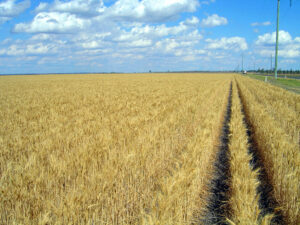The Australian Bureau of Agricultural and Resource Economics and Sciences (ABARES) released its June Crop Report last week. The June Crop Report is the first official estimate of how much area has gone into crop this autumn, and how much is expected to be produced.
The season
has only just broken in large parts of Western Australia, and areas in SA and
Western Victoria are still waiting, so any estimates made now can be subject to
significant change. Regardless, the June
crop report gives a guide to how much is expected to be sown at least.
Figure 1
shows wheat plantings are expected to be similar to last year, which makes for
five relatively steady years in a row. Wheat
production is expected to lift, with an average yield of 2.28t/ha, up from
2.04t last year.
The biggest
contributors to the increase in production are NSW and WA, both of which had weaker
yields last year. The dry start in
Victoria has ABARES cutting yields, while yields are forecast to be steady in
SA.
A 29mmt
wheat crop would be historically very strong.
There have only been five years on record which have been higher.
Barley plantings
haven’t lifted as much as we might have expected, with the lifting of tariffs
and better prices. ABARES is forecasting
a small increase in plantings and steady yields to achieve a 7% bump in
production. For barley, the forecast production
of 11.5mmt would be the fifth highest on record.
The
increases in wheat and barley area are expected to come from canola. Canola plantings are forecast to decline by
14% on the west coast, and 9% nationally.
A small increase in yields from 1.58t/ha to 1.7t will somewhat offset
the decrease in area.
National
canola production is pegged at 5.38mmt, the lowest in four years, but still
stronger than any year prior to 2021-22.
The late break in WA, SA and Victoria is partly responsible for the
decline in plantings, but there is still plenty going in compared to historical
standards. Don’t be surprised to see a
downgrade in canola plantings in the September report.
What does it mean?
If the crop report forecasts come to fruition, growers can expect prices to remain at a similar spread to international prices as in the season just gone. There is still plenty of time and potential for anything to happen, but the forecast is much more positive this year.
Have any questions or comments?
Key Points
- ABARES crop report estimates an increase in cereal production and lower canola in 2024-25.
- The late break is impacting plantings in WA, SA, and Victoria.
- Production forecasts are still expected to be strong, keeping a lid on price spreads.
Click on figure to expand
Click on figure to expand
Click on figure to expand
Data sources: ABARES, Mecardo















